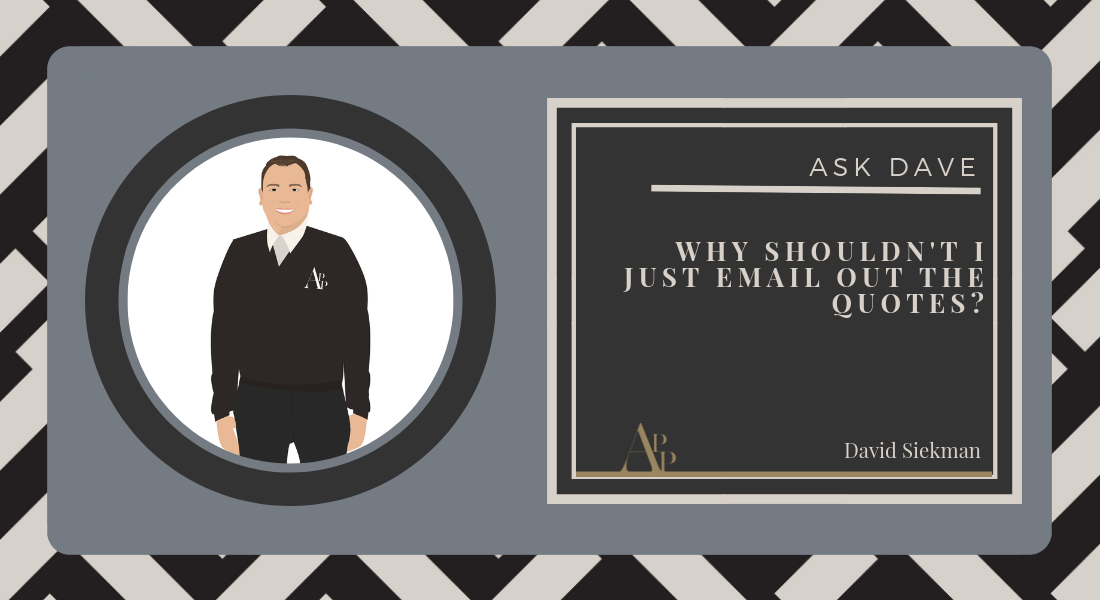There are three things that I am often asked during trainings or during speaking engagements that cause the most debate. Last week I wrote about one of those things, quoting over the phone on the first call. This week I want to tackle another, emailing out quotes (well, actually NOT emailing out quotes).
Often when talking with service and sales reps, they will tell me that they don’t email out quotes unless the client requests it. If we recognize that emailing out a quote is not the best way to present the quote, why would we do it because the client requests it? When we allow the client to dictate the customer experience, it typically ends up being poorer than when we control it. If we are sending them out even when the client doesn’t request it, we need to see how successful we are with it. If we have a high close rate, it typically means that we aren’t generating leads from a large enough variety of lead sources. Friends, family, certain referral sources are great places to generate leads and typically have a high close rate. Leads generated from other marketing efforts typically need a little more love to get them to close.
There are a few different reasons why I don’t like to email out the quote. First, it allows the prospect to take all of your hard work and simply shop what you have recommended to other agents. This is frustrating because it shows that they value your work but don’t care about service after the sale and are just going on price. Presenting the quote over the phone allows us to continue to show our value, build rapport, and talk about the benefits of doing business with our agency.
In the face of all of the advertising working to make our products commodities, we need to take every opportunity that we can to speak with the prospect. The end of the sales process is so important because it ensures that our effort did not go to waste. Some people feel that by emailing off the quote they are saving themselves effort by allowing the client to review everything on their own. In fact, they are just increasing the likelihood the effort they have put in so far will be wasted. Additionally, the time spent putting the email together, especially when it is unlikely to be read is much better spent simply explaining the options to the client on the phone.
When we just email out the quote, most prospects aren’t going to spend a lot of time actually reviewing it. They don’t read the email that took you 20 minutes to type up or look at the limits, coverages, and endorsements that you have included on the quote. They simply open up the email, open up the attachment to find the premium. In many cases, the carriers have even moved the quoted premium up to the top of the page and many now have it in a different color. This just perpetuates the idea that price is the most important item when shopping the insurance. What is the difference between that and just putting the premium right in the subject line?! It is one thing for the general public to think that price is most important; you need to show that you have a passion for protection which can only be demonstrated verbally.
When we are able to present the quote verbally, we also have the opportunity to discuss options which helps the client buy-in to the quote. People like to be involved in the process of building their policy; giving them 3-4 options on some of the finer details will increase their odds of purchasing the policy. I don’t suggest major coverages should be options, but there are differences in carriers that you can present. Package endorsements, deductibles, and billing plans are all options that can be presented so the prospect sees that you are building a policy specifically for his or her needs.
If a client does ask for a quote to be emailed, we can use the options as a reason that we are unable to send out the quote. We can always send the quote over at a later time (or the application as we will discuss below). If we explain that we need to get them back on the phone to ask some additional questions, work through some options, and finalize the quote, the client will typically understand. We can always offer to email the quote after the next discussion.
Many times, the prospect may have some concerns on what was sent (if they do actually read it). Occasionally they will respond to the email or call-in with questions, but more often they will simply feel a little confused and overwhelmed and either call someone else that will simplify it or just stay where they are because it is easier. By presenting the quote over the phone or in person, we have the opportunity to embrace and resolve these concerns.
Following up on quotes can be a very frustrating experience. Typically, the prospect doesn’t answer the phone or tells you that they haven’t had a chance to review what you’ve sent yet. This leads to an extended sales process which decreases your likelihood of the sale and makes you less efficient. Reviewing the quote over the phone allows you to move on to the next step at the end of the call. Depending on the product and the client, you may have someone that wants to look at the quote, but most of the time you can move on to sending out the application. This allows you to get some commitment and while the application doesn’t have all of the detail, it does have the limits, premium, and the information the client typically wants. By doing this, we avoid another agent from seeing the details of our work and give the client the opportunity for a simple and quick end to the process.
Instinctively, the general thought around this is that a prospect doesn’t want to get back on the phone to further discuss their insurance. But we cannot allow the prospect to dictate the process. We are the licensed professional, we need to do business the way that actually drives the best customer experience and increases the likelihood of the sale. If we are really the right agency for the client, we need to make sure that we make the sale because it is in the client’s best interest. It also makes us more effective and efficient which is in the best interest of the agency and helps with our own success while reducing follow-ups and stress.




